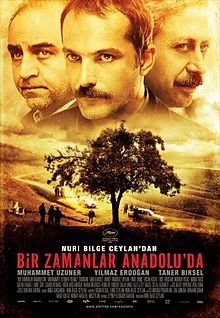Once Upon A Time in Anatolia
ONCE UPON A TIME IN ANATOLIA is a remarkable, haunting movie directed by Nuri Bilge Ceylan. Slow, almost remorseless, it tells the story of how, over one night, a group of policeman, a public prosecutor and a doctor search for the body of a murdered man. One of the murderers is sitting between two men in the back of a clapped out car and is not giving them vital clues.
Through long, beautiful shots, we watch this strange group go from well to well (they know the body is buried by a well, near a round tree) in a bleak but beautiful corner of Turkey.
At the beginning, the sun has just set and the world is shadowy and lit by the yellow headlights of the investigation’s cars. Light and dark are two powerful and sculptural elements that define the frame. Gradually, Ceylan moves his camera in closer. The men’s faces – unshaven, puffy, tired (but going to get much more tired ) are relished. What they are doing only becomes clear gradually, and before we really understand what has happened, we get little details about the men. The leading policeman has a son who worries him and needs a new prescription; the prosecutor urinates so often that the men ask the doctor if he may have a prostate problem and in the midst of this human chatter sits a man who – we will know by the end – has done a terrible thing. There is something heavy, mournful, and menacing about the murderer but when the police inspector’s patience snaps there is also something fragile about him.
But what is truly remarkable is how all of this – and much more – is painted so subtly and with so light a touch. Nothing particular tells the audience what to think, or feel, but the accumulating story, the sense of getting to visit these character’s lives, the seemingly arbitrary details all left me feeling haunted. Twenty-four hours later, the movie is still in my head; as I think about it, I understand it more, and possibly less.
It isn’t an easy film. It isn’t always clear what is going on – though that might be in part to do with subtitles – and Ceylan’s stubbornness in NOT giving us easy emotional hooks or hits is frustrating but the effect is profound. ONCE UPON A TIME IN ANATOLIA exudes confidence. It doesn’t feel the need to KNOW that it is moving the viewer and therefore, in my experience, draws the viewer to it. By the end – in a glorious final scene – we watch the doctor’s face for the slightest, tiniest clue, while hearing (and I’m not going to spoil it) sounds that quite literally fill the viewer with dread.
One reviewer compared the film to Tolstoy and Chekhov and it seems to come from the same place. An event has occurred – a man has been murdered – and rather than build a tale of suspense (a whodunnit) or even follow a complicated investigation, Ceylan uses his story to explore his characters and their reaction to events. Gradually, he lets them reveal themselves (in one major scene very literally) but doesn’t feel the need to make them more dramatic than they already are or will become.
And so the film is a lesson. How do you find the creative courage NOT to dramatise but let the honest humanity of your characters reveal themselves? How do you know by so doing that you draw the viewer, the audience, or the reader to you? How do you have the confidence to trust that a story, allowed to breathe, may tell more than you expected, understood or intended?
ONCE UPON A TIME IN ANATOLIA isn’t for the multiplex or even from the school that defiantly eschews a traditional (effect=emotional response) relationship with its audience. Rather, it is a piece on its own. Simple at first glance, and defined by understated confidence.


